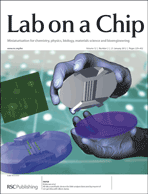 Highlighted on the outside front cover of Issue 2 we have work from Keith Neeves and colleagues creating random models of complex porous media to study microfluidic flow under more realistic settings. They based the structure of their porous media on an algorithm developed from two-dimensional Voronoi diagrams to better simulate the geometries found in media such as soil, sands, sedimentary rock or biological tissues.
Highlighted on the outside front cover of Issue 2 we have work from Keith Neeves and colleagues creating random models of complex porous media to study microfluidic flow under more realistic settings. They based the structure of their porous media on an algorithm developed from two-dimensional Voronoi diagrams to better simulate the geometries found in media such as soil, sands, sedimentary rock or biological tissues.
Single- and two-phase flow in microfluidic porous media analogs based on Voronoi tessellation
Mengjie Wu, Feng Xiao, Rebecca M. Johnson-Paben, Scott T. Retterer, Xiaolong Yin and Keith B. Neeves
DOI: 10.1039/C1LC20838A
 On the inside front cover, Anders Kristensen and colleagues depict the fabrication of silica nanofluidic devices for single-molecule studies. The purely inorganic silica can be fusion bonded and has low autofluorescence and provides a cheaper alternative to top-down processing of fused silica or silicon substrate imprints of sol–gel silica.
On the inside front cover, Anders Kristensen and colleagues depict the fabrication of silica nanofluidic devices for single-molecule studies. The purely inorganic silica can be fusion bonded and has low autofluorescence and provides a cheaper alternative to top-down processing of fused silica or silicon substrate imprints of sol–gel silica.
All-silica nanofluidic devices for DNA-analysis fabricated by imprint of sol–gel silica with silicon stamp
Morten Bo Mikkelsen, Alban A. Letailleur, Elin Søndergård, Etienne Barthel, Jérémie Teisseire, Rodolphe Marie and Anders Kristensen
DOI: 10.1039/C1LC20689C
As with all our cover articles, these are free to access for 6 weeks.
View the rest of the issue here












